Joubiniteuthidae , Joubiniteuthis
Joubiniteuthis portieri
Richard E. YoungIntroduction
Joubiniteuthis portieri is a meso- to bathypelagic squid found circumglobally in tropical and subtropical regions. This squid is unusual in possessing extremely long arms I-III that bear numerous small suckers in six series. Little is known about the biology of this squid. Perhaps it floats in the depths of the ocean with arms outstretched waiting for a small animal to accidently swim into them.
Diagnosis
A member of the chiroteuthidae families ...
- with suckers in six series on arms I-III.
- with suckers in four series on arms IV.
- with arms I-III three or more times as long as arms IV.
Characteristics
- Arms
- Arms I-III extremely long (over twice ML).
- Low web joins arms I-III.
- Arms IV short (length one third or less than length of other arms).
- Dorsal six arms with suckers in six series; ventral arms with suckers in four series.
- Tentacles
- Clubs laterally compressed.
- Clubs each bear suckers in 5-6 irregular series increasing to 8-12 series in distal third of club.
- Head
- Head elongate due to long brachial pillar.
- Beaks: Descriptions can be found here: Lower beak; upper beak.
- Funnel
- Funnel-locking apparatus with oval depression.
- Fins
- Fins short, about 30% of ML.
- Fins short, about 30% of ML.
- Tail
- Tail long (longer than the mantle), slender and bearing membranous, non-motile appendages.
- Photophores
- Absent.
Comments
More details of the description can be found here.The presence of the membranous ornamentation on the slender tail wasn't known until recent observations (2003) of the squid from a submersible (see below). Therefore, the older drawings reproduced here and on the accompanying description page show a smooth tail.
Nomenclature
A list of all nominal genera and species in the Joubiniteuthidae can be found here. The list includes the current status and type species of all genera, and the current status, type repository and type locality of all species and all pertinent references.
Life History

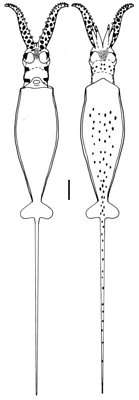
Figure. Ventral and dorsal views of a paralarva of J. portieri, 6.9 mm ML, Hawaiian waters. Scale bar is 1 mm. Drawings from Young (1991).
An advanced paralarval stage has been described (Young, 1991). The paralarva (6.9 mm ML without the tail) is very distinctive with large, thick tentacles, small fins and long tail.
Behavior
Recent observations and video recordings of J. portieri by Frank Parrish (NMFS) from a research submersible at a depth of about 1100 m have provided the only direct evidence of the behavior of this squid (see video frames below). Except for the constant beating of the tail fin, the squid's movements appeared to be in extreme slow-motion. The video indicates that the squid extends its tentacles in a manner similar to that seen in species of Mastigoteuthis and Chiroteuthis. In these squids the large tentacle-sheaths (= lateral membranes of arms IV) on the long arms IV cradle the tentacles so that the extending tentacles seem to emerge from the tips of arms IV. With arms IV spread apart laterally, the long, delicate tentacles are less likely to entangle one another. In spite of the fact that Joubiniteuthis has very short arms IV it appears to use the same tentacle-deployment strategy.

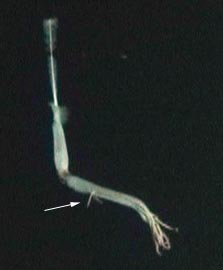
Figure. When first seen from the submersible, the J. portieri had the posture shown in the video-frame above. Two small projections (arrow) emerge between the arms that, presumably, are the tentacles.

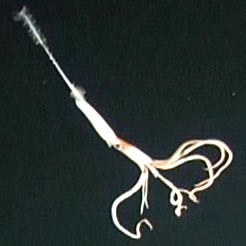
Figure. A bit later (video-frame above), the squid repositions each of its long dorsal six arms into similar loops while the ventral arms (arms IV) hang vertically downward possibly with the tentacular clubs just emerging from the tentacle-sheaths at the tips of these arms.

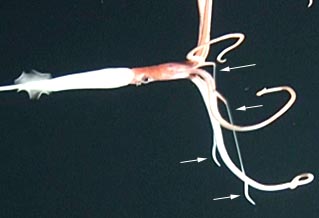
Figure. Shortly afterwards (video-frame above), the tentacles extend further and the tentacular stalks (left-pointing arrows) can clearly be seen emerging from the tentacle-sheaths of arms IV which now are angled forward. The thick, terminal clubs (right-pointing arrows) are apparent.
Distribution
Vertical Distribution
There are few unambiguous records of the depth of capture of this species. Young (1978) reported a nighttime capture (64 mm ML) in an opening-closing net at 480-550 m depth and a nighttime capture (42 mm ML) in an oblique tow that fished to 425 m. A number of captures have been made during the day or night in open tows that fished from 800 to 2500 m but the squid could have been caught during setting or retreival of the net. The submersible record, therefore, is especially valuable as it confirms the presence of the squid in deep water (about 1100 m) during the day.
Geographical Distribution
Although the records are scattered, this squid appears to occupy tropical and subtropical latitudes in the Atlantic (Young and Roper, 1969) and has been recorded off Japan (35°N, 138.5°E from the stomach of a stranded Alepisaurus ferox) and Hawaiian waters.
References
Young, R. E. (1991). Chiroteuthid and related paralarvae from Hawaiian waters. Bull. Mar. Sci., 49: 162-185.
Young, R. E. and C. F. E. Roper. 1969. A monograph of the Cephalopoda of the North Atlantic: The family Joubiniteuthidae. Smithson. Contr. Zool. No. 15: 1-10.
Title Illustrations

| Scientific Name | Joubiniteuthis portieri |
|---|---|
| Location | Off Northwestern Hawaiian Islands, 1100 m depth. |
| Comments | Photograph from Hawaii Undersea Research Laboratory Video-archive |
| Specimen Condition | Live Specimen |
| Identified By | R.E.Y. |
| View | Side |
| Size | 30-40 cm total length |
| Copyright | © Frank Parrish |
| Scientific Name | Joubiniteuthis portieri |
|---|---|
| Reference | Young, R. E. and C. F. E. Roper. 1969. A monograph of the Cephalopoda of the North Atlantic: The family Joubiniteuthidae. Smithson. Contr. Zool. No. 15: 1-10. |
| Specimen Condition | Dead Specimen |
| View | Ventral |
| Image Use |
 This media file is licensed under the Creative Commons Attribution-NonCommercial License - Version 3.0. This media file is licensed under the Creative Commons Attribution-NonCommercial License - Version 3.0.
|
| Copyright |
© 1969

|
About This Page
I thank Jane Culp (H.U.R.L) and Frank Parrish (N.M.F.S.) for providing access to the submersible video of J. portieri.

University of Hawaii, Honolulu, HI, USA
Page copyright © 2019
 Page: Tree of Life
Joubiniteuthidae , Joubiniteuthis . Joubiniteuthis portieri .
Authored by
Richard E. Young.
The TEXT of this page is licensed under the
Creative Commons Attribution-NonCommercial License - Version 3.0. Note that images and other media
featured on this page are each governed by their own license, and they may or may not be available
for reuse. Click on an image or a media link to access the media data window, which provides the
relevant licensing information. For the general terms and conditions of ToL material reuse and
redistribution, please see the Tree of Life Copyright
Policies.
Page: Tree of Life
Joubiniteuthidae , Joubiniteuthis . Joubiniteuthis portieri .
Authored by
Richard E. Young.
The TEXT of this page is licensed under the
Creative Commons Attribution-NonCommercial License - Version 3.0. Note that images and other media
featured on this page are each governed by their own license, and they may or may not be available
for reuse. Click on an image or a media link to access the media data window, which provides the
relevant licensing information. For the general terms and conditions of ToL material reuse and
redistribution, please see the Tree of Life Copyright
Policies.
- Content changed 26 March 2019
Citing this page:
Young, Richard E. 2019. Joubiniteuthidae , Joubiniteuthis . Joubiniteuthis portieri . Version 26 March 2019. http://tolweb.org/Joubiniteuthis_portieri/19450/2019.03.26 in The Tree of Life Web Project, http://tolweb.org/





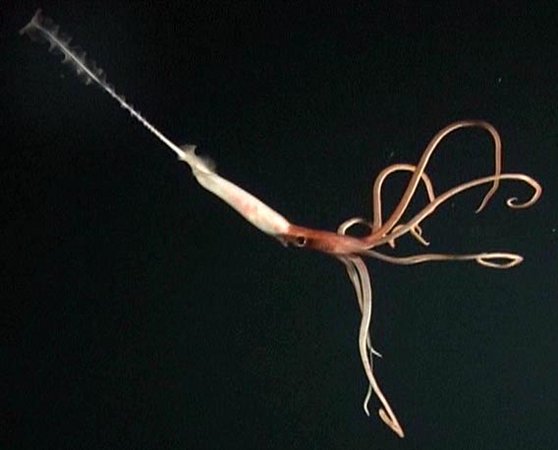



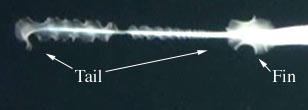
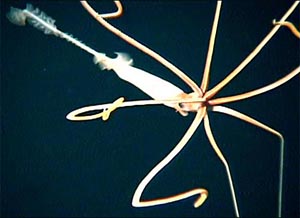
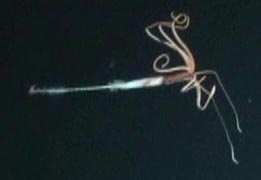
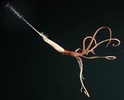



 Go to quick links
Go to quick search
Go to navigation for this section of the ToL site
Go to detailed links for the ToL site
Go to quick links
Go to quick search
Go to navigation for this section of the ToL site
Go to detailed links for the ToL site